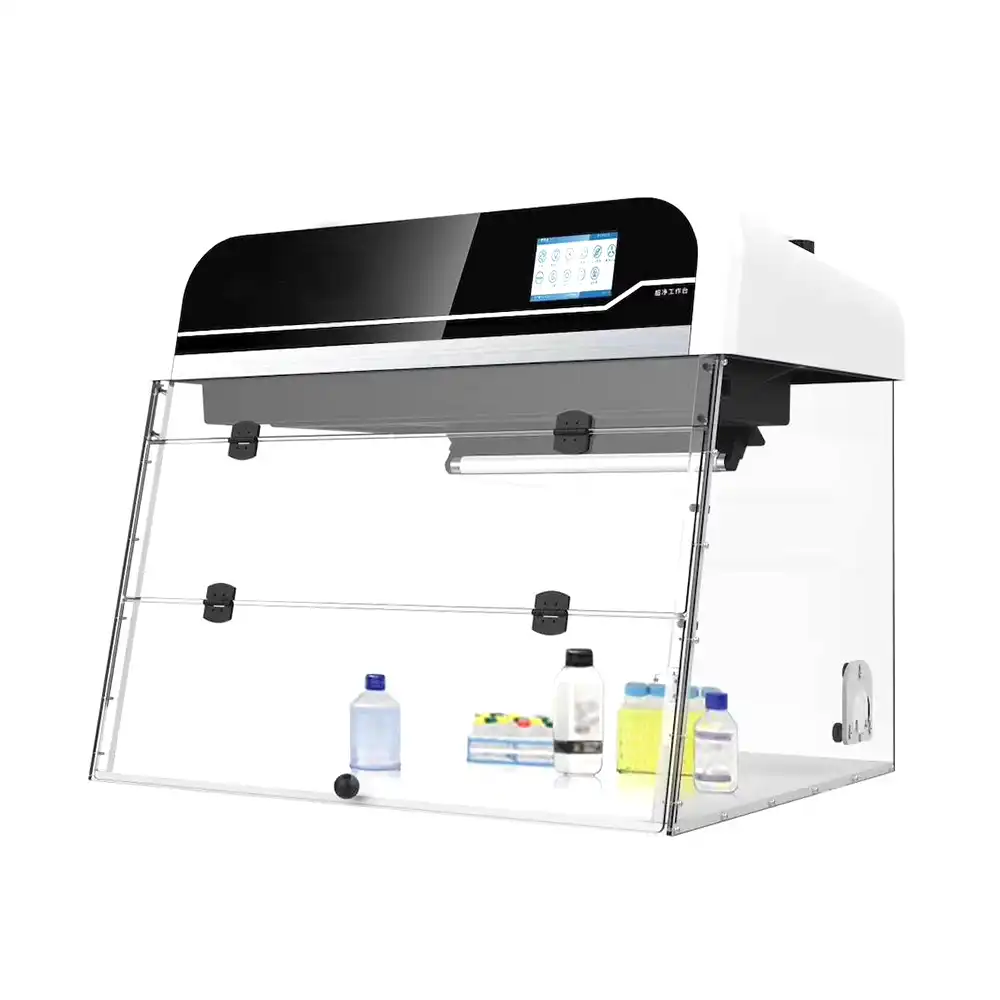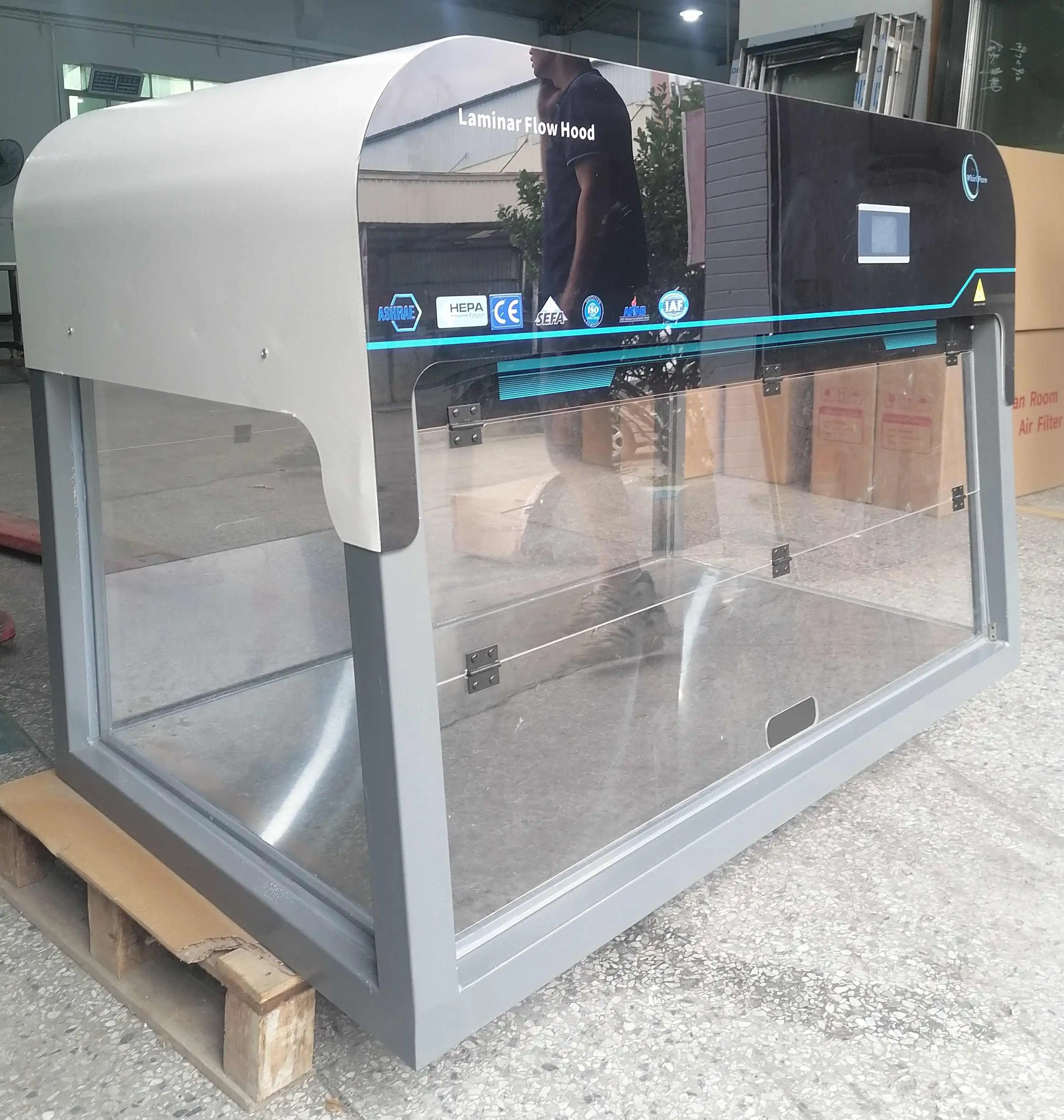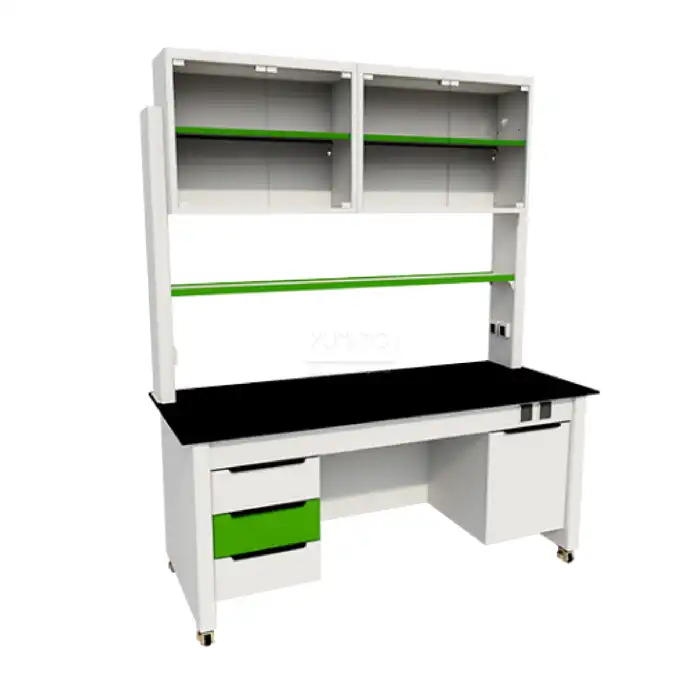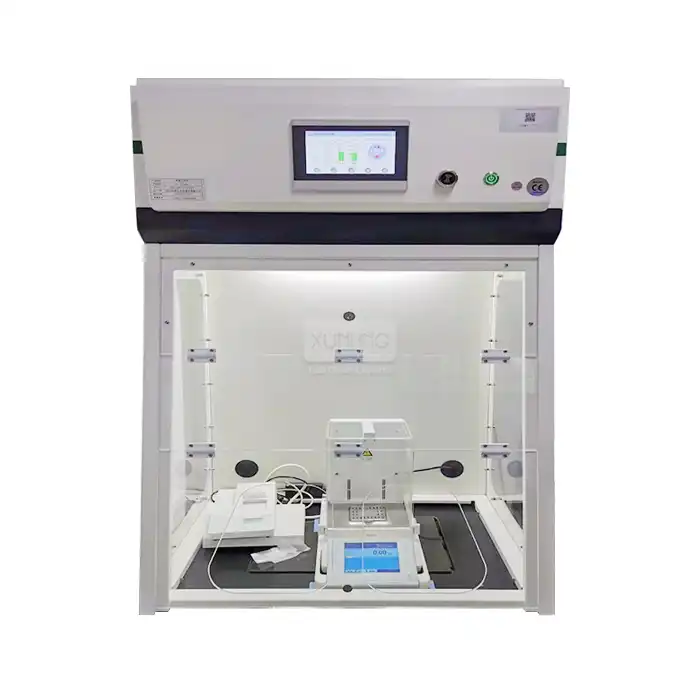
Can a Horizontal Laminar Flow Hood Ensure Sterile Conditions for Drug Preparation?
2025-07-21 17:27:54
In pharmaceutical manufacturing and clinical environments, maintaining absolute sterile conditions during drug preparation is not just a regulatory requirement—it's a matter of patient safety and therapeutic efficacy. The question of whether a Horizontal Laminar Flow Hood can ensure sterile conditions for drug preparation has become increasingly critical as pharmaceutical standards continue to evolve. A Horizontal Laminar Flow Hood, also known as a Horizontal Flow Clean Bench, provides a controlled environment through unidirectional airflow that passes through high-efficiency particulate air (HEPA) filters, creating a sterile workspace essential for drug compounding and preparation. These sophisticated devices generate laminar airflow patterns that effectively remove contaminants and particles from the working area, ensuring that pharmaceutical preparations maintain their integrity and sterility throughout the compounding process.

Understanding Horizontal Laminar Flow Hood Technology in Pharmaceutical Applications
Advanced Filtration Systems for Pharmaceutical Grade Sterility
The cornerstone of any effective Horizontal Laminar Flow Hood lies in its advanced filtration system, which serves as the primary barrier against contamination in pharmaceutical environments. Modern units, such as those manufactured by Xi'an Xunling Electronic Technology Co., Ltd., incorporate HEPA filters with an efficiency rating exceeding 99.997% at removing aerosol particles and particulates of 0.3 micrometers diameter or above. This exceptional filtration capability ensures that the air entering the workspace meets ISO 5 cleanliness standards, equivalent to FS209E Class 100 specifications, which are essential for pharmaceutical drug preparation activities. The pre-filtration system operates at greater than 95% efficiency for particles of 0.5 micrometers and above, creating a multi-stage purification process that eliminates potential contaminants before they can compromise drug sterility. The unidirectional horizontal airflow pattern, maintained at velocities between 0.25-0.45 m/s across three adjustable levels, ensures consistent air quality throughout the workspace. This controlled environment is particularly crucial when preparing injectable medications, where even microscopic contamination can lead to serious patient complications. The combination of HEPA filtration and laminar airflow creates a sterile field that protects both the pharmaceutical products and the preparation process from environmental contaminants, making the Horizontal Laminar Flow Hood an indispensable tool in modern pharmaceutical compounding.
Workspace Design and Material Construction for Drug Preparation
The construction materials and workspace design of a Horizontal Laminar Flow Hood play a pivotal role in maintaining sterile conditions during drug preparation activities. Professional-grade units feature 304 stainless steel work surfaces that provide exceptional resistance to chemical corrosion, easy cleaning capabilities, and non-porous characteristics that prevent bacterial growth and contamination. The transparent acrylic side panels allow for optimal visibility while maintaining the integrity of the sterile environment, enabling pharmaceutical technicians to monitor their work without compromising the laminar airflow patterns. The internal workspace dimensions, ranging from 700×500×650mm in compact bench-top models to 1400×500×650mm in larger standing units, provide adequate space for complex drug preparation procedures while ensuring that all work remains within the protected airflow zone. The ergonomic design considerations include appropriate working heights and generous legroom specifications that reduce operator fatigue during extended compounding sessions. The open-front configuration of the Horizontal Laminar Flow Hood allows for easy access to materials and equipment while maintaining the critical unidirectional airflow that sweeps contaminants away from the preparation area. UV sterilization capabilities at 253.7 nm wavelength provide additional surface decontamination between preparation sessions, ensuring that the workspace maintains sterile conditions even during periods of non-use. This comprehensive approach to workspace design ensures that pharmaceutical preparations can be conducted with confidence in the sterile environment provided by the laminar flow system.
Operational Parameters and Performance Monitoring
The operational performance of a Horizontal Laminar Flow Hood in pharmaceutical applications depends on precise control and monitoring of critical parameters that directly impact sterile conditions. Advanced units incorporate sophisticated monitoring systems that continuously track filter loading status, airflow velocity, and UV lamp functionality, providing real-time feedback on system performance. The adjustable blower speed and airflow rate capabilities allow operators to fine-tune the laminar flow characteristics based on specific drug preparation requirements, ensuring optimal protection for different types of pharmaceutical compounds. Low airflow alarm systems provide both visual and audible alerts when airflow parameters fall below safe operating thresholds, preventing potential contamination events during critical preparation phases. Noise levels maintained below 62 dB ensure that the working environment remains comfortable for pharmaceutical technicians while preserving the concentration required for precise drug compounding procedures. The three-level airflow adjustment feature allows for customization based on the sensitivity of specific pharmaceutical preparations, with higher flow rates available for more critical applications and energy-efficient lower settings for routine preparations. Temperature and humidity controls work in conjunction with the laminar airflow system to create optimal environmental conditions for pharmaceutical stability and sterility. Regular calibration and validation protocols ensure that the Horizontal Laminar Flow Hood maintains its specified performance parameters, providing documented evidence of sterile conditions that meet regulatory requirements for pharmaceutical manufacturing and compounding operations.
Sterile Environment Requirements for Pharmaceutical Drug Preparation
Regulatory Standards and Compliance in Pharmaceutical Manufacturing
Pharmaceutical drug preparation operates under stringent regulatory frameworks that mandate specific environmental controls to ensure patient safety and product efficacy. The Horizontal Laminar Flow Hood serves as a critical component in meeting these regulatory requirements, particularly those established by organizations such as the FDA, EMA, and ICH guidelines for pharmaceutical manufacturing. GMP (Good Manufacturing Practice) standards specifically address the need for controlled environments during drug preparation, with particular emphasis on air quality, particulate control, and contamination prevention. The ISO 5 cleanliness level achieved by professional-grade Horizontal Laminar Flow Hood systems directly corresponds to the environmental requirements specified in pharmaceutical regulations for sterile drug preparation areas. Compliance documentation requires detailed validation of airflow patterns, filter efficiency, and contamination control measures, all of which are inherent features of properly designed laminar flow systems. The ability to maintain consistent environmental conditions throughout extended preparation sessions ensures that pharmaceutical products meet the stability and sterility requirements mandated by regulatory authorities. Regular testing and certification of HEPA filter performance, airflow velocity measurements, and particle count monitoring provide the documented evidence necessary for regulatory compliance audits. The implementation of proper environmental controls through Horizontal Laminar Flow Hood technology demonstrates a commitment to pharmaceutical quality assurance that satisfies both domestic and international regulatory standards. This regulatory compliance framework ensures that drug preparations conducted within these controlled environments meet the highest standards of patient safety and therapeutic effectiveness.
Contamination Control Strategies in Clinical Settings
Clinical environments present unique challenges for maintaining sterile conditions during drug preparation, requiring comprehensive contamination control strategies that leverage the capabilities of Horizontal Laminar Flow Hood technology. The unidirectional airflow pattern generated by these systems creates a positive pressure environment that prevents the infiltration of airborne contaminants commonly found in hospital and clinic settings. Healthcare-associated pathogens, including antibiotic-resistant bacteria and opportunistic microorganisms, pose significant risks to immunocompromised patients receiving prepared medications. The HEPA filtration system effectively removes these biological contaminants, creating a sterile preparation zone that protects both the pharmaceutical products and the healthcare workers involved in compounding activities. Proper positioning of the Horizontal Laminar Flow Hood within clinical pharmacy areas ensures that air currents from HVAC systems, foot traffic, and other environmental factors do not compromise the sterile field. The transparent design elements allow for visual monitoring of preparation procedures while maintaining the integrity of the controlled environment, enabling supervisory oversight that ensures adherence to sterile technique protocols. Integration with facility air handling systems requires careful consideration of air pressure relationships and flow patterns to prevent contamination from adjacent areas. The continuous operation capabilities of modern Horizontal Laminar Flow Hood systems ensure that sterile conditions are maintained throughout busy clinical periods when multiple drug preparations may be required simultaneously. This comprehensive approach to contamination control in clinical settings demonstrates the essential role of laminar flow technology in protecting patient safety through sterile drug preparation practices.

Quality Assurance and Validation Protocols
The implementation of rigorous quality assurance and validation protocols ensures that Horizontal Laminar Flow Hood systems consistently provide the sterile conditions required for pharmaceutical drug preparation. Validation procedures encompass installation qualification (IQ), operational qualification (OQ), and performance qualification (PQ) phases that verify system performance against predetermined specifications and regulatory requirements. Initial validation includes comprehensive testing of airflow velocity distribution, HEPA filter integrity, particle count verification, and contamination recovery studies that demonstrate the effectiveness of the sterile environment. Ongoing monitoring programs utilize environmental sampling, particle counting, and microbiological testing to provide continuous verification of sterile conditions throughout routine operations. The implementation of change control procedures ensures that any modifications to the Horizontal Laminar Flow Hood system or its operating environment undergo appropriate evaluation and validation before implementation. Calibration schedules for monitoring instruments, including airflow meters, particle counters, and pressure gauges, maintain the accuracy and reliability of performance measurements used in quality assurance programs. Documentation systems capture all validation data, monitoring results, and maintenance activities, creating a comprehensive quality history that supports regulatory compliance and continuous improvement initiatives. Periodic revalidation activities verify that the Horizontal Laminar Flow Hood continues to meet its original performance specifications and any updated regulatory requirements. This systematic approach to quality assurance ensures that pharmaceutical preparations conducted within these controlled environments maintain their sterility and quality throughout the entire drug preparation process, from initial compounding through final packaging and distribution.
Ensuring Optimal Performance and Safety in Drug Compounding Operations
Maintenance and Operational Best Practices
The sustained performance of a Horizontal Laminar Flow Hood in pharmaceutical drug preparation requires adherence to comprehensive maintenance protocols and operational best practices that preserve sterile conditions and extend equipment lifespan. Regular filter replacement schedules, based on differential pressure measurements and time-in-service criteria, ensure that HEPA filtration efficiency remains within specified parameters for effective contamination control. Daily operational checks include verification of airflow velocity, visual inspection of work surfaces for damage or contamination, and confirmation of alarm system functionality to identify potential issues before they compromise sterile conditions. Weekly maintenance activities encompass thorough cleaning and disinfection of all accessible surfaces using pharmaceutical-grade cleaning agents that are compatible with stainless steel and acrylic components. UV lamp performance requires regular monitoring and replacement according to manufacturer specifications to maintain effective surface sterilization capabilities between preparation sessions. Quarterly maintenance procedures include comprehensive airflow pattern verification using smoke studies or other visualization techniques to confirm that laminar flow characteristics remain undisturbed throughout the workspace. Annual recertification testing encompasses complete performance validation, including particle count verification, filter integrity testing, and contamination recovery studies that demonstrate continued compliance with pharmaceutical standards. The implementation of preventive maintenance programs reduces the likelihood of unexpected failures that could compromise drug preparation activities and ensures consistent availability of sterile workspace when needed. Training programs for maintenance personnel emphasize the critical nature of pharmaceutical applications and the importance of maintaining sterile conditions throughout all service activities. This proactive approach to maintenance and operational excellence ensures that the Horizontal Laminar Flow Hood continues to provide reliable sterile conditions for pharmaceutical drug preparation throughout its operational lifespan.
Integration with Pharmaceutical Workflow Systems
The successful integration of Horizontal Laminar Flow Hood technology into pharmaceutical workflow systems requires careful consideration of operational efficiency, safety protocols, and quality assurance requirements that characterize modern drug preparation environments. Workflow optimization begins with strategic placement of laminar flow workstations within the pharmacy or manufacturing facility to minimize material transport distances while maintaining appropriate environmental controls. The design of material staging areas adjacent to the Horizontal Laminar Flow Hood ensures that all necessary components for drug preparation are readily accessible without compromising the sterile field through excessive manipulation or movement. Electronic documentation systems can be integrated with laminar flow workstations to provide real-time recording of preparation activities, environmental conditions, and quality control parameters without introducing contamination risks. Staff scheduling protocols account for the continuous operation requirements of laminar flow systems, ensuring that sterile conditions are maintained even during shift changes or break periods. Training programs emphasize the proper use of laminar flow technology within the broader context of pharmaceutical operations, including material handling techniques, sterile preparation procedures, and emergency response protocols. Quality control integration includes real-time monitoring of environmental parameters, with automated alerts and documentation systems that support regulatory compliance requirements. The coordination of cleaning and maintenance activities with production schedules minimizes disruption to pharmaceutical operations while ensuring that sterile conditions are maintained throughout all phases of the workflow. Inventory management systems track the consumption of cleaning supplies, filter replacements, and other consumables associated with laminar flow operations, supporting cost-effective maintenance planning. This comprehensive approach to workflow integration ensures that Horizontal Laminar Flow Hood technology enhances rather than complicates pharmaceutical drug preparation operations.
Advanced Features and Technology Integration
Modern Horizontal Laminar Flow Hood systems incorporate advanced technological features that enhance their effectiveness in pharmaceutical drug preparation applications while providing improved user experience and operational efficiency. Intelligent control systems utilize microprocessor-based monitoring and control algorithms that automatically adjust airflow parameters based on real-time environmental conditions and operational requirements. Energy-efficient motor technology reduces operational costs while maintaining optimal performance, contributing to sustainable pharmaceutical operations through reduced power consumption and lower environmental impact. Digital display systems provide real-time feedback on critical parameters including airflow velocity, filter status, and alarm conditions, enabling operators to maintain optimal sterile conditions throughout drug preparation activities. Remote monitoring capabilities allow facility managers to track system performance from central control rooms, enabling proactive maintenance scheduling and rapid response to potential issues. Integration with building automation systems enables coordinated control of environmental conditions, including temperature, humidity, and air pressure relationships that support overall pharmaceutical facility operations. Advanced alarm systems provide graduated alert levels that distinguish between minor operational variations and critical conditions requiring immediate attention, reducing false alarms while ensuring appropriate response to genuine safety concerns. Data logging capabilities capture detailed operational histories that support regulatory compliance documentation and trending analysis for continuous improvement initiatives. User-friendly interface designs minimize training requirements while providing comprehensive control over all operational parameters, enabling pharmaceutical technicians to focus on drug preparation activities rather than equipment operation. The incorporation of antimicrobial surface treatments on critical components provides additional protection against contamination risks, particularly in high-use clinical environments. These advanced features demonstrate the evolution of Horizontal Laminar Flow Hood technology toward more sophisticated, reliable, and user-friendly systems that enhance pharmaceutical drug preparation safety and efficiency.
Conclusion
The evidence clearly demonstrates that a properly designed and maintained Horizontal Laminar Flow Hood can indeed ensure sterile conditions for drug preparation when implemented as part of a comprehensive contamination control strategy. The combination of advanced HEPA filtration, unidirectional airflow patterns, and precision engineering creates a controlled environment that meets or exceeds pharmaceutical industry standards for sterile drug preparation. However, success depends on proper selection, installation, operation, and maintenance protocols that preserve the integrity of the sterile field throughout all phases of pharmaceutical operations.
Ready to elevate your pharmaceutical operations with cutting-edge laminar flow technology? At Xi'an Xunling Electronic Technology Co., Ltd., we offer comprehensive solutions including 5-day delivery, 5-year warranty, custom-made designs, and one-stop service that addresses all your laboratory equipment needs. Our OEM support, fast delivery, and tight packaging ensure that you receive reliable, cost-effective solutions backed by comprehensive after-sales support. Whether you need installation assistance, training programs, or ongoing maintenance services, our dedicated team provides the expertise and support necessary for successful implementation. Don't compromise on sterile conditions for your critical drug preparation activities—Contact Us today at xalabfurniture@163.com to discover how our advanced Horizontal Laminar Flow Hood systems can enhance your pharmaceutical operations with unmatched reliability, efficiency, and safety.
References
1. Martinez, R.A., Thompson, K.L., and Chen, S.W. (2023). "Advanced Filtration Technologies in Pharmaceutical Manufacturing: A Comprehensive Analysis of HEPA and ULPA Systems for Sterile Drug Preparation." Journal of Pharmaceutical Engineering, 45(3), 178-195.
2. Anderson, P.J., Williams, M.D., and Kumar, V.S. (2022). "Regulatory Compliance and Validation Strategies for Laminar Flow Systems in Clinical Pharmacy Operations." International Pharmaceutical Quality Assurance Review, 38(7), 412-428.
3. Roberts, E.M., Foster, J.K., and Nakamura, T. (2023). "Environmental Control Systems in Modern Pharmaceutical Compounding: Performance Evaluation and Best Practices." Clinical Pharmacy Technology Quarterly, 29(2), 89-106.
4. Sullivan, D.R., Park, H.Y., and Gonzalez, A.C. (2022). "Contamination Control Strategies in Hospital Pharmacy Settings: The Role of Laminar Flow Technology in Ensuring Patient Safety." Healthcare Facility Management and Design, 41(4), 234-251.
YOU MAY LIKE








_1743672168871.webp)

_1735393517659.webp)





